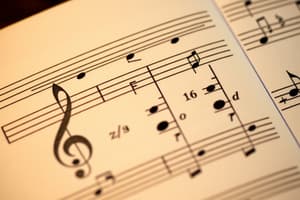Podcast
Questions and Answers
What does rhythm primarily consist of?
What does rhythm primarily consist of?
- Only silence
- Only sounds
- Only beats
- Patterns of sounds and silences (correct)
Which element describes the first beat of a measure in rhythm?
Which element describes the first beat of a measure in rhythm?
- Accent (correct)
- Count
- Meter
- Measure
What is meant by 'time signature' in music?
What is meant by 'time signature' in music?
- A group of pulse beats
- An indicator of the appropriate counting for rhythmic patterns (correct)
- The speed at which music is played
- A measure of the volume of sounds
Which of the following is NOT an element of dance?
Which of the following is NOT an element of dance?
Which term refers to the speed of the music?
Which term refers to the speed of the music?
What does the term 'loco-motor movement' describe?
What does the term 'loco-motor movement' describe?
What is defined as a natural grouping of measures in music?
What is defined as a natural grouping of measures in music?
What is the primary focus of the body as the instrument in dance?
What is the primary focus of the body as the instrument in dance?
Which of the following is an example of a non-locomotor movement?
Which of the following is an example of a non-locomotor movement?
What characterizes manipulative movements?
What characterizes manipulative movements?
Which of the following best describes 'asymmetrical positioning' in movement?
Which of the following best describes 'asymmetrical positioning' in movement?
Which element of time in movement relates to the speed of the performance?
Which element of time in movement relates to the speed of the performance?
What does the term 'level' in movement refer to?
What does the term 'level' in movement refer to?
Which one of the following is not a form of structure in music?
Which one of the following is not a form of structure in music?
What is the primary focus of spatial qualities in movement?
What is the primary focus of spatial qualities in movement?
In dance, what does 'sensed time' refer to?
In dance, what does 'sensed time' refer to?
Flashcards are hidden until you start studying
Study Notes
Rhythm
- Arrangement of sounds moving through time, characterized by regular recurrence of elements such as beats and accents.
- Composed of sounds and silences; patterns formed by repeating sounds create rhythm.
- Has a steady beat but can include a variety of beats.
- Noise lacks pattern; rhythmic sounds have a defined structure.
Elements of Rhythm
- Accent: Emphasis on the first beat of a measure.
- Bar: Vertical lines on a staff dividing music into equal measures.
- Beat: The basic pulse or underlying rhythm of the music.
- Count: A specific pulse beat serving as a time limit.
- Intensity: Variation in stress or movement within rhythm.
- Measure: A grouping of pulse beats.
- Meter: Framework defining how beats are organized into measures.
- Note: Symbol representing a musical tone.
- Note Pattern: Set of notes used to guide dance movements.
- Phrase: Natural grouping of measures in music.
- Pitch: Highness or lowness of a tone.
- Step Pattern: Movements corresponding to dance steps.
- Tempo: Speed at which music is played.
Time Signature
- Indicates counting for specific rhythmic patterns, commonly grouped in twos, threes, or fours.
Movement
- Movement is essential for life, rooted in responses to gravity.
- Centers of movement in the body: gut, heart, and head.
Elements of Dance
- Body: Defines movement capabilities, including shapes, balance, weight transfer, and flight.
- Fundamental Movements:
- Locomotor Movements: Move the body through space (e.g., walking, running, leaping).
- Non-Locomotor Movements: Stationary actions (e.g., bending, swaying).
- Crawl and Roll: Movements involving multiple supports and orientation.
- Manipulative Movements: Combine locomotor and non-locomotor actions with objects (e.g., throwing, juggling).
Space
- The environment for movement; spatial qualities focus on direction and level.
- Shape: Visual component in dance; can be symmetrical or asymmetrical.
- Level: Relationship of the body’s position relative to the floor or apparatus.
- Path/Floor: Movement trajectories and directions.
- Dynamics: Variations in force and energy during movement.
Time
- Organized in various ways (clock time, event-sequence).
- Dancers may use visual or sensed cues for timing in phrases.
- Includes elements like duration, tempo, rhythm, and accent emphasis.
Form
- Structure or design for music themes and arrangements.
- Involves concepts such as theme or variation, canons/fugues/rondos, suites, narratives, and more.
Studying That Suits You
Use AI to generate personalized quizzes and flashcards to suit your learning preferences.




